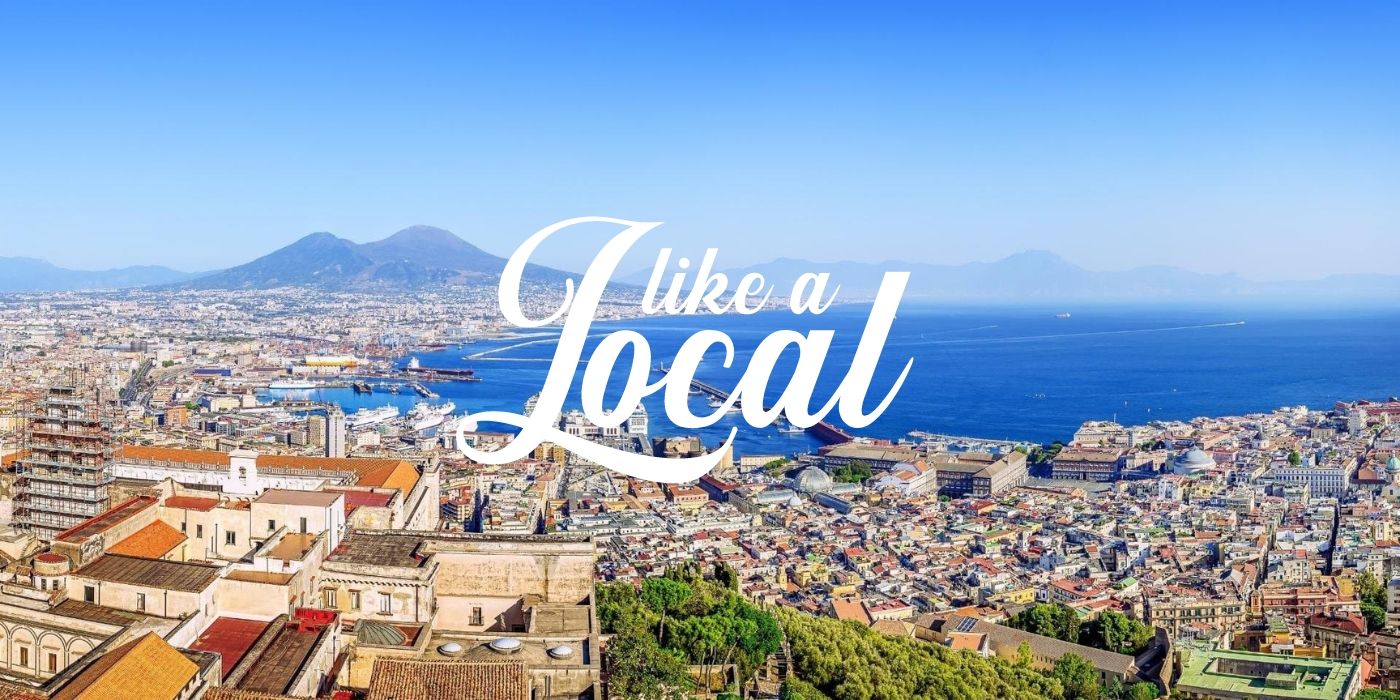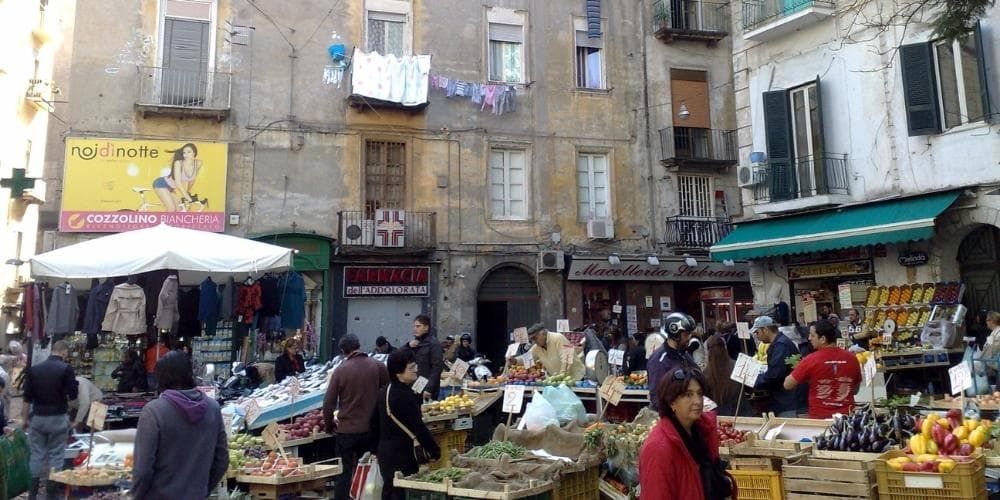What to do and see in Naples? You can't simply visit a city that is so lively and vibrant, volcanic and ingenious: you have to live it.
What better way to experience Naples than by taking inspiration from the Neapolitans.
Here is our guide to the things to do in Naples like a local.

Non touristy things to do in Naples. Discover what to do in Naples like a local

Brace yourself for offbeat Naples.
Put aside stereotypes and prejudices and discover a romantic and seductive city that surprises at every corner.
We will help you get around Naples as a true local would. Here are our favourite places to take the perfect picture, have a night out and get some exercise in style. Let's go!
Ps: Would you prefer to listen to this article in the podcast version? Press play in the box below!
Get your Naples Pass and visit Naples like a local10. Non touristy things to do in Naples like a local. Visiting Vomero
Vomero is a hilly and chic district where you can enjoy long walks among shops, green areas and Art Nouveau buildings.
Its ideal and moral centre is Piazza Vanvitelli, whose symbol is an ancient clock dating from the 1930s, an authentic witness to Neapolitan history, stories and generations. Via Bernini and Via Scarlatti, the most famous shopping boulevard, start from here. Also, the place is linked to one of Naples' most beautiful panoramic areas—ten minutes of ramps and climbs, and you reach the astonishing Belvedere di San Martino, with the namesake Carthusian Monastery, a must for anyone staying in the city.
Other highlights include Castel Sant'Elmo, the only castle in the world whose shape resembles a six-pointed star; the wonderful Villa Floridiana, with its magnificent park and the Museo Nazionale della Ceramica Duca di Martina; and Villa Santarella, the former residence of Neapolitan playwright Eduardo Scarpetta.
According to Gambero Rosso's Guide to Street Food 2023, you find the best-fried food in Campania in Vomero's Piazzetta Fuga, a gluttonous reference point for those searching for exciting flavours.
This refined neighbourhood is one of the best-connected areas of the city. Therefore, it's a perfect headquarters for those staying in Naples.
Do you need any suggestions for accommodation? Take notice! Vomero High Hotel is a modern and cosy facility on Via Traversa Imperatrice. We love its strategic location near the metro (Policlinico stop), the tasteful environment, comfortable rooms, and attentive service. It's the ideal place for having a bit of relaxation before your next activity in town.
Book a room at Vomero High Hotel9. Learning to drink local lemonade
Wait, what? Well, what may seem obvious in any other place, it's not to be taken for granted when in Naples. Traditions long established in a city full of peculiar customs and rituals may appear somewhat extravagant to outsiders but also definitely extraordinarily amusing!
That's the case of a simple, impressive, 'explosive' local drink. You can order it in small and picturesque kiosks, ideal heirs of the ancient 'acquafrescai' and water banks—kind of street vendors of the 18th and 19th centuries.
So, how are you supposed to drink the famous Neapolitan lemonade? First of all, let's have a look at the ingredients: sparkling water, lemon juice and a pinch of baking soda with a deflagrating effect. The only way to keep clean clothes is to open your legs, lean slightly forward and drink your limonata as fast as possible. You'll love it or hate it. Anyway, you'll surely have some fun!
Book Naples food tour8. Discovering one of the coolest neighbourhoods in the world
The British magazine Time Out has named it one of the 51 coolest neighborhoods in the world, the only Italian on the list. Baroque palaces, murals, artisan shops and a thriving and delightful food scene make it a must-see.
We are talking about the colourful and characterful Rione Sanità, where the highest degree of the napoletanità is reached. It's the place to visit for meeting the authentic, offbeat Naples. The cultural and artistic ferment that pervades the district sited between Capodimonte and the historic centre makes it one of the most dynamic and original areas.
Here, you can still buy handmade gloves as in the 19th century; the clothes hanging out of the windows are not folklore, but an everyday practice; and food is both poetry and redemption: it's not a case if the symbol of the district's regeneration is a local pastry, Il Fiocco di Neve (snowflake).
You have more options to enjoy Rione Sanità and its life explosion. Stroll among street art and murals; visit the extraordinary Fontalenne Cemetery, the Catacombs of San Gennaro and San Gaudioso; look for the childhood home of Neapolitan actor and legend Totò (it's at 109 Via Santa Maria Antesaecula); and peer at the entrance to the astonishing Palazzo dello Spagnuolo among the stalls of the Vergini market. The Royal Palace of Capodimonte is only a few minutes walk away.
Finally, we leave you with an extra tip for visiting Naples and its historic center in the most authentic way, but without getting overwhelmed by its wonderful chaos. We suggest to plan your trip a little in advance, buying a tourist pass such as the Naples Pass, that allows you to visit museums and attractions and travel on the city's public transport without any worries. Choose Naples Pass and explore the city with ease, like a true Neapolitan.
Book Rione Sanità tour7. Walking among Maradona murals
You write Diego Armando Maradona, and you read dios, god. Neapolitans have made the legendary Napoli football team's captain an idol worthy of adoration. And how can a deity be properly worshipped if not with a dedicated altar?
Maradona's shrine is located in Via San Biagio dei Librai and boasts a relic, too. The English label says "Kapel Original of Maradona", a direct translation of "Capello originale di Maradona". Once exposed on the street, the "miraculous" dark hair is now placed inside Bar Nilo (find it at number 129).
This is just a few steps away from the Duomo and another relic, one of the emblems of Naples: the blood of San Gennaro. As customary for this city, sacred and profane meet and contaminate each other with a brilliant nonchalance.
Actually, Naples is teeming with tributes to the Argentine football star. Fans' love has lasted over thirty years and hasn't waned even after the player's death on 25 November 2020. Maradona, Diego, as the locals call him, is part of Naples.
There is a place more representative than others of this strange, crazy feeling. To find it, you have to venture to Quartieri Spagnoli and reach Largo Maradona, an open-air temple dedicated to the god of football.
At number 60 Via Emanuele de Deo stands a large mural created in 1990 to celebrate Napoli's second scudetto. The little square is a true pilgrimage destination in the heart of the historic centre. A must-see even if you are not a football fan.
Abandoning the classic tourist routes (and even fears and prejudices) for a few hours, you will come across many creations of this type, especially in the more popular neighbourhoods.
In Vico Lungo Gelso, there is a ceramic mosaic by the Italian-French street artist duo "I Puffi di Oplontis".
In Vico Giardinetto stands the symbolic image of "La Mano de Dios" by San Spiga, the Argentine artist who has scattered the Spanish Quarter with the effigy of El Pibe de Oro. Just stroll through the area's narrow alleys, and you'll spot many of them, primarily posters made from Sergio Siano's photographs.
Even in Rione Sanità, iconic actor Totò's neighbourhood, there are many tributes to the footballer, including the big face depicted by street artist Raffo ART, Antonio Cotecchia's print in Via Lammatari, and the niche with the jubilant Maradona in the church of San Vincenzo.
Head to the south-western outskirts of Naples, San Giovanni a Teduccio, to photograph what is probably the most famous Maradona mural in the world. "Dios Umano", the monumental opera by Jorit, is located in Via Taverna del Ferro.
Find more about street art in Naples.
Book the 'Naples of Maradona' walking tour6. Having an aperitif in Piazza Bellini
What to do in Naples in the evening? Piazza Bellini is one of Neapolitans' favourite spots. If you're looking for a place where you can mingle and toast with the locals and experience non touristy things to do in Naples, this historic corner in Decumano Maggiore is definitely for you.
The nerve centre of Neapolitan nightlife, Piazza Bellini is actually very busy at all hours of the day thanks to its fascinating cultural scene, literary cafés, bistros, bars and clubs where you can stop for an aperitif and stay up late into the evening.
Thanks to its proximity to University Federico II, the Academy of Fine Arts and Conservatorio di San Pietro a Majella, Piazza Bellini is a lively and noisy meeting place for young people.
Shows, live music and events are never lacking, especially in spring and summer, the perfect seasons to stop with friends and have a drink outdoors.
Piazza Bellini is a five-minute walk from the nearest metro station, Dante.
Go there even if you're not in the mood for happy hour. The ancient Greek walls, Renaissance and Baroque buildings (Palazzo Firrao, Palazzo Conca, Palazzo Castriota Acanderbeg) and the proximity to so many other cultural points (we are in the middle of the Neapolitan UNESCO World Heritage area) make Piazza Bellini a must-see.
Book Naples walking tour5. Eating a fried cuoppo in the historic centre
Eating on the street in Naples is not just for tourists.
Whether it's the climate, the urban structure, the dynamic habits of the people or the culinary tradition, street food is a way of life. Neapolitans are the biggest fans of their takeaway delicacies.
Want to eat as the locals do in Naples? Follow the crowd and sharpen your ears. If you see a queue outside a friggitoria and hear the unmistakable dialect, don't hesitate to join in.
You may have to wait a while, but when the gruff-looking lady at the till calls your turn, you'll understand what's so special about Naples street food that makes people huddle in the sun outside shoe-box sized shops.
Pasta frittatas, croquettes, panzarotti, rise balls, pumpkin flowers—all strictly fried and caloric. And cheap, because street food in Naples is democratic. Just a few euros in exchange for a hot, crispy explosion of flavours.
Go all in and order a cuoppo, a wrapper made of baking paper and filled with delicacies fresh from the hot oil. Enjoy them while strolling through the streets of the historic centre. And if you're still hungry after the last bite, continue with a pizza, fried or "a portafoglio", to strictly eat on the road.
The centro storico is overflowing with rotisseries and friggitorie, often so small that they would almost go unnoticed if it weren't for the aromas they waft through the streets.
Spaccanapoli, Via dei Tribunali and San Biagio dei Librai do not fail to meet the expectations of gourmands. The fact that the whole city hides little gems behind every "vico" (narrow street) and unsuspected corner is something you will only discover when in Naples.
Asking locals for advice on where to eat is a technique that always pays off. Neapolitans are true gourmets and will suggest the coolest places to taste the best offbeat Naples has to offer.
Book Naples's guided street food tour4. Shopping at the Pignasecca market
One of the most popular markets with Neapolitans is in an area known as Pignasecca, in the heart of the Quartieri Spagnoli.
It is the oldest open-air market in Naples. The nearest metro stations are stunning Toledo, on Line, and Montesanto, on Line 2.
According to legend, the name Pignasecca refers to the ancient presence of a dried-up pine tree (pigna in Neapolitan). You can find it just behind Via Toledo, the famous shopping street.
The atmosphere is authentically Neapolitan, lively, folkloristic, warm and chaotic. As you make your way through stalls full of fresh fish, fruit, vegetables and clothing and traders shouting in thick dialect, you will feel like an authentic Neapolitan.
The area is teeming with characteristic rotisseries, pizzerias and small kiosks to stop for a taste of the local cuisine at very low prices (tripe is a speciality to try).
Take advantage of your shopping session in Pignasecca to visit one of the oldest churches in the historic centre, the church of Santa Maria di Montesanto, and the monumental church of San Nicola alla Carità.
Book Naples Market tour3. Walking up and down the steps of Naples
Naples is an oblique city that climbs from the sea to the hills. If you're on a diet and think you've overindulged with pizza and fried snacks, you're in a perfect place to work off the excess calories.
Climbs, ramps and steps link the districts in an unexpected secret itinerary very much off the typical tourist trail.
Want to take pictures of the city from a different and unusual perspective? You may have to (literally) sweat it out to get the perfect shot, but the views you'll catch are worth the exercise.
There are more than two hundred staircases in Naples. From bottom to top, they cross streets and neighbourhoods, passing ancient churches, monasteries, rioni suspended in time, and postcard panoramas. A few examples?
Petraio is one of the most famous and evocative stairs. Built in the 16th century to link the Chiaia and Vomero neighbourhoods, it takes you from the Art Nouveau hillside architecture to the narrow alleyways of the "bassi" (the street-level apartments of the city's underclass).
La Pedamentina is one of the oldest and most iconic Neapolitan climbs. From Corso Vittorio Emanuele, it takes 414 steps to reach the Carthusian monastery of San Martino. With its hairpin bends and views covering Capodimonte and Vesuvius, it's definitely one of the most beautiful to photograph.
Gradini Piazzi join Moiariello to Via Foria. These are Sophia Loren's stairs in the movie "Yesterday, Today and Tomorrow" by Vittorio De Sica.
The Steps of Capodimonte or Princess Jolanda's Stairs are monumental construction dating from the 19th century. They connect the Royal Palace and Museum of Capodimonte with the Catacombs of San Gennaro.
Book Naples bike tour2. Kayaking around Gaiola
Opposite Posillipo is a small island as captivating as mysterious. It is called Gaiola, a place famous in Naples for being jellato, unlucky. A gloomy reputation linked to the ruinous fortunes of the now uninhabited 19th-century villa emerging from the rocks and its numerous owners.
Do as the locals do and, in spite of any superstition, don't get discouraged from visiting the shoreline. You have to arrive at Parco Virgiliano and continue to Discesa Gaiola, where a steep flight of steps awaits you.
The little beach in front of the island is top-rated, but access is by reservation only (book your entrance online via the Marine Protected Area Gaiola website).
Gaiola is located in Italy's most beautiful marine protected area, Parco Sommerso di Gaiola, which stretches from the picturesque village of Marechiaro to the Trentaremi Bay.
The waters along this stretch of coastline contain Roman archaeological remains. It goes without saying that snorkelling here will be an exceptionally thrilling experience.
Just a few strokes, and you can easily reach the islet (actually two large tufa rocks joined by a narrow bridge). However, given the area's incredible beauty, we recommend hiring a kayak and setting off in exploration.
Just nearby, there are the remains of a partially submerged Roman residence, Palazzo degli Spiriti (Palace of the Spirits). If the legend is right, you might even meet the poet Virgil. Tide permitting, try kayaking in and see if rumours are true.
Book Naples sunset cruise + aperitif1. Watching the lights of Naples from Belvedere di San Martino

Naples is full of vantage points, perfect for kicking off the evening by watching the sun dip into the Gulf or simply admiring the city.
The terrace of San Martino, just below the Carthusian monastery and Castel Sant'Elmo, is one of Neapolitans' favourite places on the Vomero hill.
It is not uncommon to come across children playing football with a Super Santos ball, couples of lovers and young people eating a takeaway pizza sitting on a bench.
The view from Belvedere di San Martino takes in much of the old town. You can easily spot the bell tower of Santa Chiara, Spaccanapoli, Piazza Dante and Castel dell'Ovo.
The show is guaranteed as the street lamps and the glow shimmering from the building windows light up the city in the evening.
After a stop on the terrace of San Martino, decide whether to go higher and enjoy an even more complete view from Castel Sant'Elmo. Or walk towards the historic centre down Petraio, the steps connecting Vomero to Corso Vittorio Emanuele.
About the author
Written on 12/08/2024






Lorena Calise
Experience Napoli as Neapolitans do. Get inspired by our suggestions and find the non touristy things to do in Naples.